Use 'Print preview' to check the number of pages and printer settings.
Print functionality varies between browsers.
Printable page generated Friday, 26 April 2024, 9:20 PM
Study Session 2 Environmental Pollution and Health
Introduction
In Study Session 1 you read about urbanisation and how its trends are challenging WASH service provision. You also saw how urbanisation can have a negative impact on the environment. In this study session you will consider environmental pollution issues related to WASH and the implications for the health of communities.
Later in the module, you will learn how these issues might be tackled through community engagement (Study Session 6), influencing behaviour (Study Session 9) and promoting improved hygiene and sanitation (Study Session 10).
Learning Outcomes for Study Session 2
When you have studied this session, you should be able to:
2.1 Define and correctly use each of the key words printed in bold. (SAQ 2.1)
2.2 Give examples of different types of waste that can be causes of air, water or soil pollution. (SAQs 2.2 and 2.3)
2.3 Identify the major health risks associated with poor access to, or improper use of, WASH facilities. (SAQ 2.4)
2.4 Explain the relationship between current practices that result in environmental pollution and health issues. (SAQ 2.4)
2.1 What is environmental pollution?
The environment should be clean and safe and provide healthy surroundings for people and other living things. However, continued expansion of urban areas, industrialisation and population growth are causing environmental damage. Large quantities of industrial and community waste, as well as human bodily waste, are released into the environment every day. The effect of continued disposal of untreated waste and release of harmful substances is called environmental pollution.
Global warming is one well-known effect of environmental pollution, caused primarily by increased concentration of carbon dioxide in the atmosphere, but there are many others. Many people are exposed to smoke from motor vehicles, burning wood or charcoal on a daily basis, which can cause respiratory infections. Industrial waste containing toxic chemicals causes contamination of water resources. Fertilisers and pesticides used by farmers are easily washed by rain into run-off water, eventually reaching surface water sources, such as rivers, and groundwater sources, such as wells and springs. Moreover, many wastes can also lead to pollution and degradation of soil, making it impossible to grow crops and other plants successfully. Examples of potential soil pollutants include waste from dumping sites, industry, vehicle workshops and chemical fertilisers.
There are many different causes of environmental pollution related to different types of waste; these are described in the following sections.
2.2 Solid waste
Solid waste means all types of waste in solid form. It includes organic waste such as paper and leftover food, and inorganic waste such as plastic bags, cans and condoms. (Organic waste includes anything that is derived from living organisms; it decomposes by natural processes. Inorganic waste does not decompose so easily.)
Urban households and businesses generate a significant amount of solid waste. Plastic materials are long-term threats to the environment as they do not decompose easily. Coloured plastics are of particular concern because the sources of their colour are heavy metals such as lead, copper and chromium that are toxic to the environment. Use of plastics, particularly coloured ones, is actively discouraged in some countries, as is the case in India (Pradhan, 2000). However, their intensive use continues in developing countries such as Ethiopia, which adds to environmental pollution.
In schools, waste paper is a major component of the solid waste and where adolescent girls are students, menstrual pads can be an additional waste.
Restaurants, cafeterias and hotels generate a substantial volume of waste on a daily basis, including vegetables and other surplus food. These organic wastes quickly start to decompose, creating a strong and unpleasant odour and encouraging the growth of microbial pathogens (disease-causing agents). In addition, organic waste attracts mosquitoes, flies and rats, which can be responsible for spreading diseases. Such animals and insects are referred to as vectors of disease.
Health centres and clinics create different kinds of solid waste including used needles, gloves and bandages contaminated with body fluids from patients. These are all hazardous wastes that can cause harm to people. Waste in healthcare facilities is considered critical because new infections can occur in people dealing with the waste if it is not handled safely. Healthcare facilities are usually provided with incinerators that burn the waste at high temperatures to kill pathogens and remove any risk of new infections. Some facilities may have special storage containers for ‘sharps’ (i.e. items such as needles and razor blades), covered placenta pits for anatomical waste (blood, body parts), and open pits for other medical waste.
Market centres and public gathering areas produce significant volumes of organic and inorganic solid waste, such as plastic bags and packaging materials (Figure 2.1). Not only does accumulated solid waste create favourable conditions for pathogens and vectors to breed, it is also unsightly and a source of unpleasant odours.

To protect urban communities from these health threats it is critically important to establish a waste management system. A waste management system includes the complete chain of service from waste collection, through transportation, to final disposal in appropriate locations. This may include informal waste collectors and waste pickers, who make a living from waste (Figure 2.2).
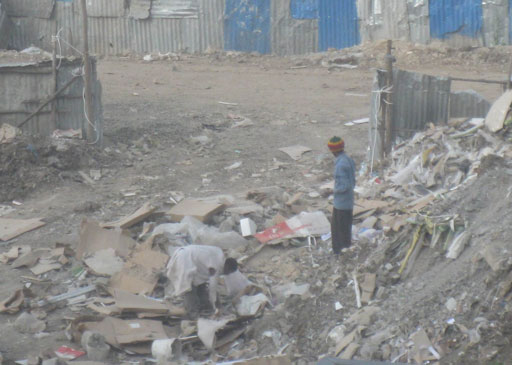
In ideal conditions, solid wastes are safely collected and transported to a designated dumpsite. In practice, a significant proportion of waste fails to reach the dumpsite quickly. The resulting waste accumulation from households, institutions and industries can be significant. Often, this accumulated waste is meant to be temporarily stored before being transported to the final dumpsite. However you may have noticed the condition of containers, skips or barrels near where you live and seen the threats posed by such transient waste. Figure 2.3 shows an overflowing skip and illustrates the unsightly result of an inefficient system that doesn’t move waste in a timely manner.
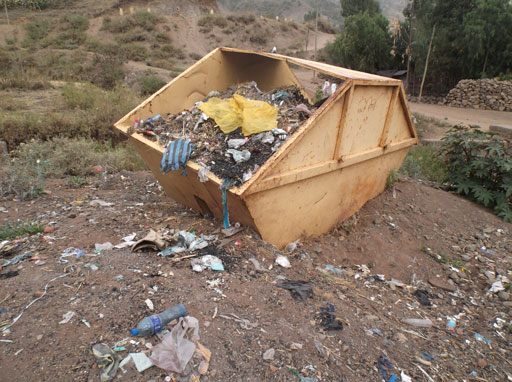
Final disposal sites should have adequate facilities and be well managed to avoid threats to the people working in them. However, in most towns designated disposal sites with necessary equipment and/or infrastructure are not yet established. Efficient systems are needed along the complete chain of service – from collection to disposal – in order to protect urban communities from health threats.
Where population density is very high and adequate latrine facilities are unavailable, communities may use buckets or plastic bags for handling excreta. Sometimes such excreta is thrown to solid waste collection spots in the hope that they will be removed along with other waste material, a practice sometimes known as flying toilets. Human excreta contains harmful pathogens that can cause disease and is a health risk if not buried or treated. Flying toilets are particularly dangerous if thrown into rivers or recreational areas. In slums, or where adequate latrines have not been built, it is always prudent to assume that solid waste may contain human excreta.
Sometimes anal cleansing materials are collected into waste bins and eventually removed from the facility along with other solid wastes. Such wastes are obviously contaminated by human excreta and may pose additional health risks.
So far you have been learning about the direct impact of solid wastes. Solid wastes can also block drainage canals and flood channels, causing them to fill up and overflow, leading to problems like the situation illustrated in Figure 2.4.
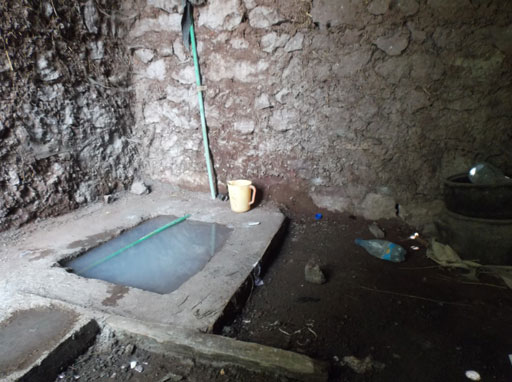
List the major solid waste contaminants of the environment.
The major contaminants in this category are:
- organic waste from households, cafeterias and restaurants
- medical wastes
- plastics – especially coloured ones
- paper, cardboard and packaging waste.
If left in the open, as in the case of ‘flying toilets’, then faeces are also in the solid waste category.
What kinds of solid waste are commonly produced by:
- a.a household
- b.a school
- c.a health centre?
The answers are:
- a.A household might produce food waste such as vegetable peelings, leftover food, plastic bottles, bags, condoms and used menstrual pads.
- b.A school might produce food waste, waste paper and also used menstrual pads.
- c.A health centre might produce food and plastic waste as well as medical waste such as used bandages, syringes, needles, etc.
Instead of just discarding solid waste, a better approach to waste management is to adopt the 3 Rs approach. The 3 Rs stand for reduce, reuse and recycle. These three options can all contribute to improvements in the problems of waste disposal in urban areas. In order of preference, they are:
- Reduce the amount of waste produced. For example, throw away less food and avoid heavily packaged items.
- Reuse items many times before throwing them away. Bottles, plastic containers and bags can all be reused (Figure 2.5).
- Recycle wastes by using them to make new items. For example, paper waste can be recycled to make fire briquettes.
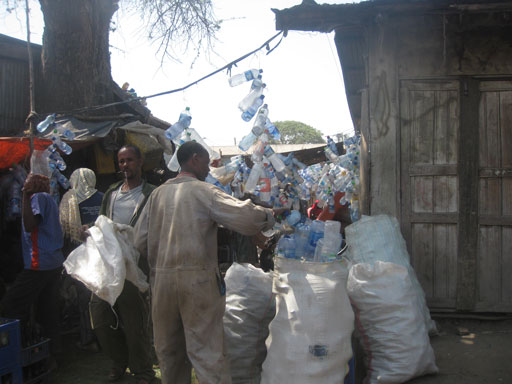
2.3 Liquid waste
Liquid waste includes human excreta (both faeces and urine), industrial wastewaters, and other forms of waste from water-using activities in homes and institutions.
Households produce liquid waste from baths, showers and handwashing, as well as from washing dishes and clothes. This liquid waste is called greywater.
Faeces and urine are called blackwater. Blackwater is produced from water-flushed toilets and contains excreta, the flushing water and the anal cleansing materials (e.g. toilet paper) that people dispose of when using toilets. This waste may be transported in sewers to a treatment plant but is more likely to be held in a septic tank, which provides partial treatment of human waste. Liquid waste also includes human waste in pit latrines, even though there is no added water.
As you can imagine, public and private institutions, such as restaurants, cafeterias, hotels, bus terminals and market places which service large numbers of individuals, produce significant volumes of both blackwater and greywater.
Industries also release a significant volume of liquid waste. In addition to waste produced by the workers during routine hygiene and sanitation activities, the processes in factories may produce liquid waste. For example, hide processing factories, coffee washing facilities, and building projects use large volumes of water. Sometimes the wastes include chemicals that have been added as part of the industrial process and may be toxic. If waste produced from these facilities is released directly to a nearby stream or river without prior treatment (see Figure 2.6), the environmental pollution risk and the effect on a community’s health is of significant concern.
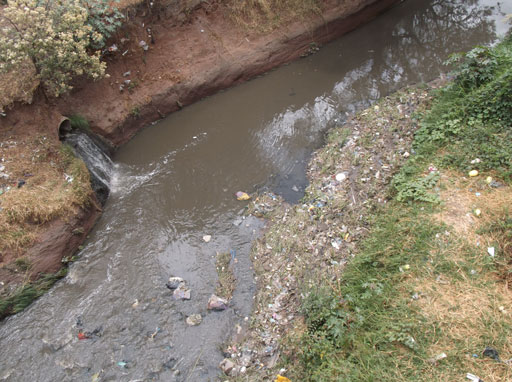
Medical facilities such as hospitals and health centres produce large volumes of liquid waste because hygiene is critically important for healthcare. Such waste may contain dangerous pathogens and can present a significant health risk to visitors, patients, healthcare workers and people handling the waste. It is therefore crucial for liquid waste to be treated appropriately.
Liquid waste is mostly water but it may also include:
- human waste (faeces, toilet paper, urine, vomit and blood)
- pathogens such as bacteria, viruses and parasites
- organic matter (e.g. animal faeces, vegetable and plant pieces)
- chemicals (e.g. pharmaceuticals), industrial wastes and toxins such as pesticides from agriculture.
The detrimental effects of these constituents on the environment can be minimised or eliminated by applying appropriate transportation and treatment technologies. Liquid waste is ideally transported using a well-engineered network of pipes and canals. Treatment technologies for liquid wastes should be applied at the point where the wastes are produced or before they are released into the environment at a disposal site. However, in most urban areas of Ethiopia, both the transportation infrastructure and the appropriate treatment facilities are lacking, so liquid waste is often released into the environment without treatment (Figure 2.6). Eventually the contaminated water is likely to be reused by people living downstream, putting community health at serious risk.
2.4 Surface and groundwater
Pollutants from liquid waste can seep into groundwater or flow into rivers or lakes. Where wells and boreholes are used to access groundwater for drinking and domestic purposes, or surface water from rivers is used for such purposes, this can introduce a high level of risk. The major danger in urban Ethiopia is contamination from faeces, although pesticides and industrial waste may also cause contamination of water. Figure 2.7 summarises potential sources of water contamination.
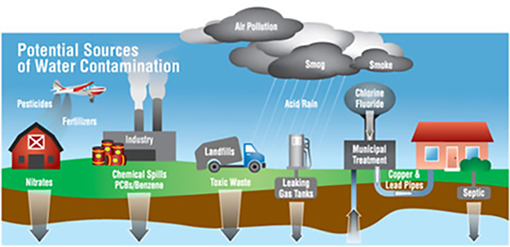
List two major environmental contaminants in the liquid waste category and explain why they pose a health risk.
You may have thought of:
- human excreta from pit latrines and septic tanks, which may contain dangerous pathogens
- liquid medical wastes from health centres, which may also contain pathogens
- industrial wastewater, which may contain toxic chemicals.
2.5 Excreta and faecal sludge
Human excreta is of immediate health concern to communities because:
- a.Faeces contain pathogens that cause disease. Children under five years of age are particularly vulnerable.
- b.In many urban areas, faeces are currently not contained, collected and disposed of safely.
The combined effect of the presence of pathogens and inefficiencies in waste management systems leads to an increasing risk of new infection. If these problems can be brought under control the health risks associated with infection as a result of contact with faecal matter can be avoided.
Of the two reasons (a) and (b) given above, which do you think might be easier for us to control?
It is easier to control (b). Human faeces always contain pathogens and there is nothing we can do about it. However, we can manage how faeces are disposed of and prevent contamination of the environment.
Pit latrines and septic tanks are appropriate sanitation options but they must be properly built and maintained to reduce the risk of groundwater contamination. In particular, latrines should be lined with an impermeable (watertight) material. If they are just lined with stone walls, the contents of the pit will seep out near the surface and pathogens in faeces may eventually be washed out into the surrounding soil. From there they can contaminate groundwater, nearby rivers, springs or water pipes. People will eventually drink the contaminated water. Contamination from animal faeces may also be an issue. For example chicken excrement can contain high levels of pathogenic bacteria, which can cause health issues for humans.
Flying toilets are particularly dangerous because human faeces are discarded close to where people are conducting their daily chores. Flies thrive and breed on faeces and organic wastes. They can easily transfer faeces to the food or water we use, ultimately leading to pathogens being ingested by people living in the nearby communities, resulting in disease.
Open defecation is the practice of excreting faeces in the open rather than in a latrine, and is common practice in highly populated corners of urban areas, as well as in peri-urban settings where adequate latrines are not available. People practise open defecation because there is no suitable alternative. The possibility of pathogens from faeces reinfecting people is very high in this situation.
Where latrines are available, they may become overfull if not emptied regularly. As a result, faecal matter may overflow the pit and become a contamination risk in the same way as open defecation or flying toilets.
Faecal waste that accumulates in the bottom of pits and septic tanks is called faecal sludge, septic sludge or simply sludge. Inefficiencies in sludge management systems can increase the chances of contaminating the environment during collection, transport or disposal of sludge.
Management and appropriate disposal of human excreta is a key environmental issue. It is important to remember the inevitable link between human excreta and disease. That is why building latrines, encouraging their proper use and promoting handwashing stand out as key strategic interventions to reduce the incidence of disease.
2.6 Air pollution
Due to industrialisation trends worldwide, particularly in developed countries, the pollution level in the atmosphere has increased significantly. Air pollution can lead to disease. In particular, polluted air can irritate a person’s trachea (windpipe) and lungs, which may affect breathing.
Air pollution is caused by the release of small particles and gases into the surrounding air. For example, motor vehicles release significant amounts of carbon monoxide and particulate material. Smoke from domestic fires, coal-based power generation and heavy industries (see Figure 2.8), and methane from waste disposal sites, all contribute to air pollution.

In urban areas, the air contains more pollutants than in rural areas because the day-to-day activities in urban areas are continually releasing pollutants into the atmosphere. For example the increase in motor vehicles and construction activities has led to Addis Ababa becoming noticeably more smoggy than it was five or ten years ago. Older vehicles that are poorly maintained are particularly likely to produce clouds of black smoke – as you have probably seen!
At the household level, using wood and charcoal for cooking purposes can contribute to indoor air pollution, which may result in some individuals being exposed to highly polluted air.
2.7 Major health risks associated with environmental pollution
So far you have learned how different categories of waste (solid waste, liquid waste including human excreta, and air pollutants) pollute the environment and can have a serious effect on human health. Table 2.1 summarises the major health problems associated with wastes and pollution.
| Contamination | Waste category | Related health problems |
| Bacteria, protozoa, viruses and parasites such as intestinal worms | Human excreta | Acute watery diarrhoea (AWD), dysentery, cholera, typhoid fever, ascariasis, schistosomiasis, polio, and intestinal infections caused by roundworm, whipworm and hookworm |
| Heavy/toxic metals | Industrial wastes Plastics | Continued and long-term ingestion of heavy metals can cause cancer and have direct toxic effects |
| Smoke (very small airborne solid particles) | Vehicle emissions Domestic fires Industrial emissions | Respiratory infections, pneumonia, in severe cases lung cancer can occur |
| Carbon monoxide | Vehicle emissions | Can cause acute respiratory problems and death |
| Viruses | Medical wastes containing body fluids from patients | HIV/AIDS infections Hepatitis |
Of all the health risks identified in Table 2.1, the problem of contamination with human excreta has the greatest impact. Globally, diarrhoea is the second most common cause of death in children under five years of age (Walker et al., 2013, cited in Brown et al., 2013). Worldwide, 807 million people are infected with the Ascaris worm that causes ascariasis (Hotez et al., 2008, cited in Brown et al., 2013).
It is clear that there is a significant disease burden on urban communities because waste is not efficiently managed. Access to proper latrines is one crucial area of WASH service that can help to reduce or eliminate the major health risks related to faeces given in Table 2.1. Solid waste collection, transport and disposal are essential areas of service. Pit emptying, which ensures faecal sludge is collected and disposed of safely, is particularly important to minimise the health risks to local communities. The government of Ethiopia is therefore putting considerable emphasis on working to improve these particular WASH services in urban areas.
List the major health risks associated with poor access to, or improper use of, latrine facilities.
The major health risks are waterborne diseases related to faeces such as acute watery diarrhoea, dysentery, ascariasis, cholera, typhoid fever and intestinal worm infection.
These health risks do not affect everyone in the same way. Certain segments of urban communities are more vulnerable to the effects of environmental pollution than others.
Which groups of people were identified in Study Session 1 as being particularly vulnerable in urban communities?
Young children, the elderly, people with disabilities, people living with HIV/AIDS or infected by other diseases, and poor families are the main vulnerable groups.
Exposing these vulnerable people to an additional disease burden can significantly affect their health status. For example, if people already living with HIV/AIDS are infected by diarrhoea, their lives can be threatened, which can have serious implications for those providing care and support, as well as having a substantial economic impact on the families involved.
Poor people are a particularly vulnerable group. They are likely to live near waste dumpsites because they cannot afford to live in areas where there is a proper infrastructure. They may be the first people to be exposed to the effects of accumulated waste. They are also the most likely people to be hired to work in the collection and transportation of waste, but because proper protective clothing and equipment are often lacking, they are exposed to infection as they go about their daily work. Some in extreme poverty, commonly called rag pickers (or korales), try to survive by collecting reusable waste. Their health is at continuous risk due to their constant exposure to wastes.
When disease affects those in vulnerable groups, it may spread to the entire urban community. For WASH services to be effective they need to be designed and implemented to reach everywhere and everyone.
List some of the poor environmental practices seen in urban communities. Explain the relationship between these practices and the health problems they may cause.
Poor environmental practices include:
- throwing faeces away in plastic bags
- open defecation
- inappropriate construction of pit latrines
- dumping solid waste without care
- using wood or charcoal for cooking indoors.
The first three in this list can all cause the spread of infectious diseases that are transmitted from person to person through pathogens in faeces. Dumping solid waste carelessly can create conditions that encourage breeding of disease vectors. Respiratory infection due to polluted air is another risk area, which can result from the last point.
Summary of Study Session 2
In Study Session 2, you have learned that:
- Environmental pollution is the release of harmful substances into water, air or soil.
- Solid waste is produced by households, industry, institutions and healthcare facilities and includes organic and inorganic materials. It should be properly collected, treated and disposed of to protect the environment and human health.
- Reducing, reusing and recycling waste are better options than simply throwing it away.
- Liquid waste includes human excreta and other waste waters. It is essential to ensure excreta is separated from people and to protect water sources from contamination by liquid waste.
- Examples of surface and groundwater pollution include contamination by human excreta, pesticides used in agriculture and toxic chemicals from industries.
- Examples of air pollutants include smoke, carbon monoxide, carbon dioxide and methane. The main sources are domestic fires, industrial activity and motor vehicles. Air pollution can cause respiratory infections.
- There are major health risks associated with water pollution, caused when people use water or food contaminated by faeces. Open defecation, improper use of latrines, disposing of faeces with solid waste or in fields are among the unhealthy practices that promote infection by disease. Unattended solid waste accumulation encourages flies and rodents to breed; they are responsible for transmitting disease.
- Some sectors of the community are particularly vulnerable to the health risks created by environmental pollution.
Self-Assessment Questions (SAQs) for Study Session 2
Now that you have completed this study session, you can assess how well you have achieved its Learning Outcomes by answering these questions.
SAQ 2.1 (tests Learning Outcome 2.1)
Match the following words to their correct definitions.
Using the following two lists, match each numbered item with the correct letter.
vector
faecal sludge
greywater
pathogen
blackwater
a.disease-causing agent
b.wastewater containing human excreta
c.sludge that builds up in pit latrines and septic tanks
d.used water from domestic washing, food preparation, etc.
e.organism that transmits disease
- 1 = e
- 2 = c
- 3 = d
- 4 = a
- 5 = b
SAQ 2.2 (tests Learning Outcome 2.2)
Which of the following statements are false? In each case explain why it is incorrect.
- A.Exhaust gases from industries and motor vehicles are major causes of air pollution.
- B.Medical wastes should be collected and disposed of with normal household waste.
- C.Organic solid waste from households, cafeterias and restaurants provide breeding places for pathogens and vectors.
- D.Faeces are an environmental pollutant when left in the open, as in the case of flying toilets.
- E.Industrial wastewater can cause water pollution if discharged directly into a river but is safe to spread over bare ground.
Answer
B is false. Medical waste should not be handled with normal household waste. It needs special disposal because it may contain hazardous substances including body fluids from patients, pharmaceutical chemicals and sharp objects such as needles.
E is false. Industrial wastewater can cause water pollution if discharged into a river but can also pollute soil and groundwater if spread over the ground.
SAQ 2.3 (tests Learning Outcome 2.2)
By what route do pollutants get into rivers and other surface waters?
Answer
Contaminants can flow directly into surface water sources, such as rivers, from pipes and drainage channels, e.g. industrial wastewater from a factory. They may also enter rivers in rainwater run-off that has washed over surrounding land and collected pollutants from any wastes discarded there, including faeces. Another possible route is from groundwater. If groundwater in the area has become contaminated, this may seep out into the river. You may also have thought of direct contamination from activities in the river water such as cleaning dirty vehicles.
SAQ 2.4 (tests Learning Outcomes 2.3 and 2.4)
What are the major health risks from:
- a.open defecation
- b.allowing food waste and litter to accumulate in a ditch
- c.not washing hands before eating.
Briefly explain how these risks could be reduced.
Answer
- a.If faeces are deposited in open areas then pathogens can be washed into rivers and groundwater (see answer to SAQ 2.3). Also flies are likely to transfer pathogens from faeces onto food. Many diseases are caused by ingesting contaminated food or water, including diarrhoea, dysentery, cholera, typhoid, and infection by intestinal worms and other parasites.
These problems could be reduced by providing sufficient numbers of well-designed and maintained latrines so that people did not have to defecate in the open.
- b.If food and other organic waste is allowed to accumulate it will encourage flies and rats to breed, which are vectors of disease. It is possible that piles of waste will also contain excreta so the risks will be the same as those listed in (a).
These problems could be reduced by providing a waste management service that ensured wastes were collected and disposed of appropriately.
- c.Handwashing before eating is an important aspect of good hygiene practice. Without this there is a risk of transmitting pathogens into your mouth, which may result in the faecally transmitted diseases listed in (a).
These risks could be reduced by ensuring everyone has access to sufficient water to make it easy to wash hands routinely and by introducing community programmes to inform people about the benefits of handwashing and good hygiene.